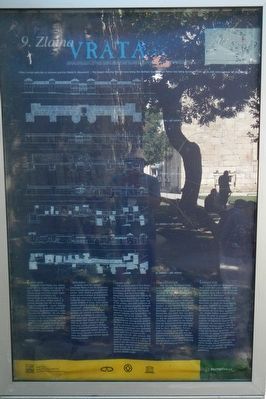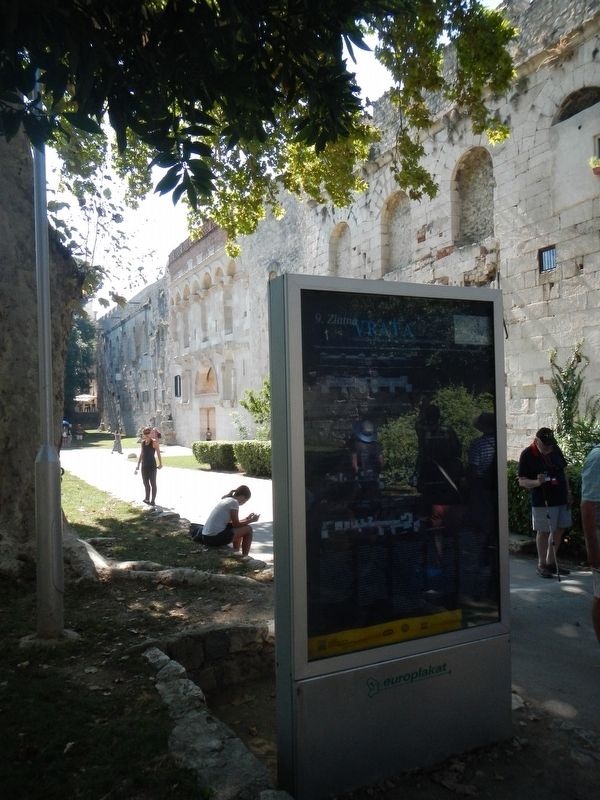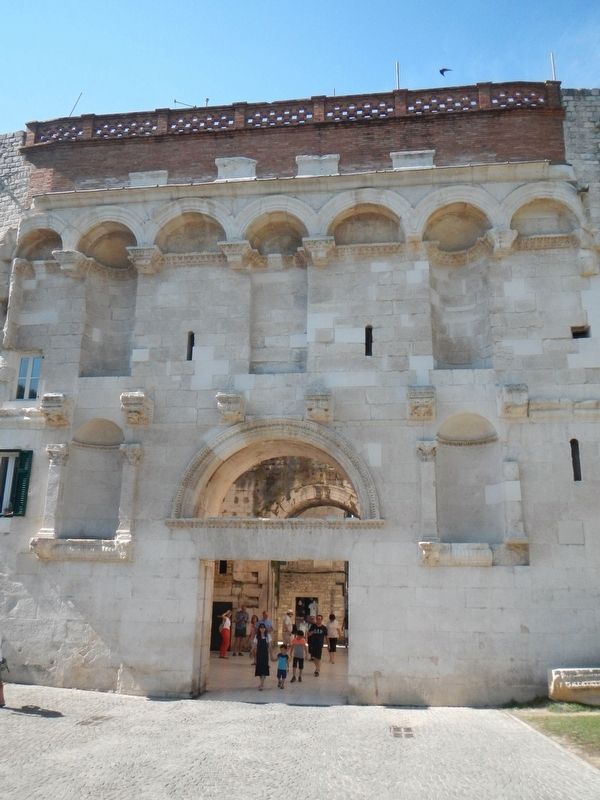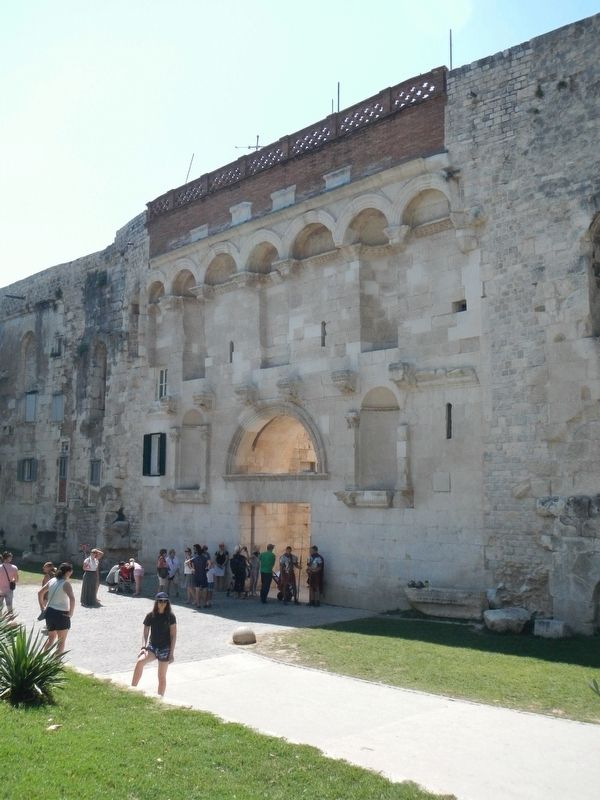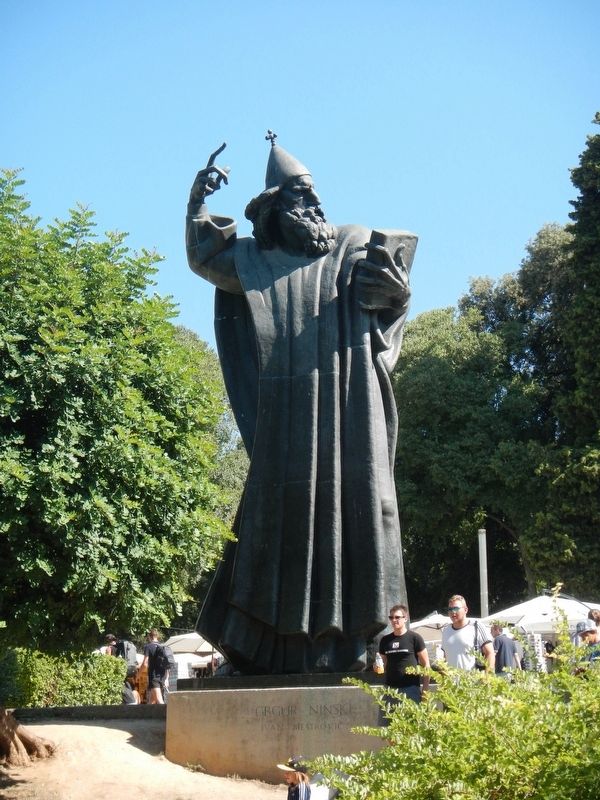Split in Opcina Split, Split-Dalmatia, Croatia — Central and Southeastern Europe
Zlatna Vrata
(Golden Gate)
Inscription.
The text of this marker appear at the bottom in five languages; Croatian, Italian, English, German and French. Only the English text (center) has been transcribed. To view the text in another language , click on the marker image to enlarge and display them.
(Side A:)
The northern gate of the Palace (called the Golden Gate) had been conceived as the main entrance to the Palace and so it had been elaborately decorated with statutes of the Emperor Diocletian and his co-regent Maximilian, in the upper row of the niches, and with sculpture of an eagle as symbol of Jupiter, between the two. There were the statues of their two successors to the thorne - caesars Galerius and Constantine - in the lower row of the niches. This conclusion can be made on account of the imperial iconography pattern, effective at the time of tetrarchy (rule by four persons). On top of the wall, there have been four pedestals preserved until the present day (while there were five of them on the drawings from the 18th century), that could have been used as a supporting base for statues, but it is unlikely to believe that the imperial figures would have been repeated twice on the same facade. So far there has not been a veritable explanation given for this double usage.
(Side B:)
Above the Golden Gate, there was an Early - Croatian Church of St. Martin built in the outer walls used by the sentry, probably in 6th century. This can be concluded by the patron saints, to whom the other gates of the imperial Palace had been dedicated: St. Theodore (The Western Gate), St. Apollinaire (The Eastern Gate) and St. Julian (The Southern Gate). St. Martin was a patron saint of soldiers, like St. Theodore, and was worshipped in the Roman times, particularly in the West., during the rule of Emperor Justinian (527-565). The small church in the corridor has been altered several times. The present appearance is a replica of the early Croatian church from 6th century, with an altar partition in pre-Romanesque style added in 11th century, which has been preserved at its original site until the present day. This peculiarity ranks the small church of St. Martin among the best preserved sacral monuments of the ancient world. Today, this small church is an integral part of the Dominican nunnery.
Erected by Grad Split, Gradosro Poglavarstvo. (Marker Number 9.)
Topics. This historical marker is listed in these topic lists: Churches & Religion • Forts and Castles • Notable Buildings.
Location. 43° 30.568′ N, 16° 26.422′
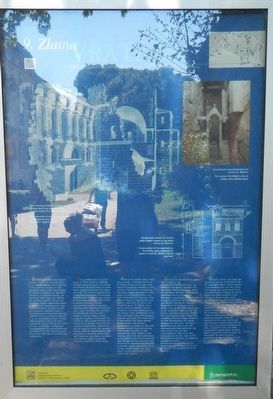
Photographed By Barry Swackhamer, July 29, 2018
2. Zlatna Vrata Marker, Side B
Captions: (left) Recontruction of the Golden gate with an octagonal tower, northern facade of the Palace (G. Niemann, 1920); (upper-right) The interior of St. Martin's church (dated early Middle Ages); (lower-right) Cross-section of the outer wall at the Golden gate, showing the space in which St. Martin's church was built.
Other nearby markers. At least 8 other markers are within walking distance of this marker. barokni Bedemi (a few steps from this marker); vrata od Pisture (within shouting distance of this marker); The Golden Gate Palace (within shouting distance of this marker); The Church of St Martin (within shouting distance of this marker); The Dragišić (De Caris) Palace (about 90 meters away, measured in a direct line); The Large Papalić Palace (about 90 meters away); The Cambi Palace (about 90 meters away); The Marulić Palace (about 120 meters away). Touch for a list and map of all markers in Split.
More about this marker. The marker is located near the statue of Grgur Ninski (Gregory of Nin).
Additional keywords. Zlatna Vrata
Credits. This page was last revised on February 10, 2022. It was originally submitted on January 8, 2019, by Barry Swackhamer of Brentwood, California. This page has been viewed 133 times since then and 13 times this year. Photos: 1, 2, 3, 4, 5, 6. submitted on January 8, 2019, by Barry Swackhamer of Brentwood, California.
